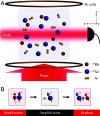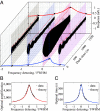Observation of magnetic amplification using dark spins
- PMID: 38640344
- PMCID: PMC11047100
- DOI: 10.1073/pnas.2315696121
Observation of magnetic amplification using dark spins
Abstract
Quantum amplification enables the enhancement of weak signals and is of great importance for precision measurements, such as biomedical science and tests of fundamental symmetries. Here, we observe a previously unexplored magnetic amplification using dark noble-gas nuclear spins in the absence of pump light. Such dark spins exhibit remarkable coherence lasting up to 6 min and the resilience against the perturbations caused by overlapping alkali-metal gas. We demonstrate that the observed phenomenon, referred to as "dark spin amplification," significantly magnifies magnetic field signals by at least three orders of magnitude. As an immediate application, we showcase an ultrasensitive magnetometer capable of measuring subfemtotesla fields in a single 500-s measurement. Our approach is generic and can be applied to a wide range of noble-gas isotopes, and we discuss promising optimizations that could further improve the current signal amplification up to [Formula: see text] with [Formula: see text]Ne, [Formula: see text] with [Formula: see text]Xe, and [Formula: see text] with [Formula: see text]He. This work unlocks opportunities in precision measurements, including searches for ultralight dark matter with sensitivity well beyond the supernova-observation constraints.
Keywords: magnetic amplification; noble gas; quantum sensing; spin magnetic resonance.
Conflict of interest statement
Competing interests statement:The authors declare no competing interest.
Figures




Similar articles
-
Amplification mechanism with interacting atomic gases.Proc Natl Acad Sci U S A. 2025 May 13;122(19):e2419683122. doi: 10.1073/pnas.2419683122. Epub 2025 May 8. Proc Natl Acad Sci U S A. 2025. PMID: 40339125
-
Cooperative Spin Amplifier for Enhanced Quantum Sensing.Phys Rev Lett. 2024 Sep 27;133(13):133202. doi: 10.1103/PhysRevLett.133.133202. Phys Rev Lett. 2024. PMID: 39392977
-
Isotope engineering for spin defects in van der Waals materials.Nat Commun. 2024 Jan 2;15(1):104. doi: 10.1038/s41467-023-44494-3. Nat Commun. 2024. PMID: 38168074 Free PMC article.
-
The cosmological constant problem and running vacuum in the expanding universe.Philos Trans A Math Phys Eng Sci. 2022 Aug 22;380(2230):20210182. doi: 10.1098/rsta.2021.0182. Epub 2022 Jul 4. Philos Trans A Math Phys Eng Sci. 2022. PMID: 35785977 Review.
-
Searches for exotic spin-dependent interactions with spin sensors.Rep Prog Phys. 2024 Dec 13;88(1). doi: 10.1088/1361-6633/ad99e6. Rep Prog Phys. 2024. PMID: 39626315 Review.
Cited by
-
Amplification mechanism with interacting atomic gases.Proc Natl Acad Sci U S A. 2025 May 13;122(19):e2419683122. doi: 10.1073/pnas.2419683122. Epub 2025 May 8. Proc Natl Acad Sci U S A. 2025. PMID: 40339125
References
-
- Goldenberg H. M., Kleppner D., Ramsey N. F., Atomic hydrogen maser. Phys. Rev. Lett. 5, 361 (1960).
-
- Breeze J. D., Salvadori E., Sathian J., Alford N. M., Kay C. W., Continuous-wave room-temperature diamond maser. Nature 555, 493–496 (2018). - PubMed
-
- Oxborrow M., Breeze J. D., Alford N. M., Room-temperature solid-state maser. Nature 488, 353–356 (2012). - PubMed
-
- Kraus H., et al. , Room-temperature quantum microwave emitters based on spin defects in silicon carbide. Nat. Phys. 10, 157–162 (2014).
LinkOut - more resources
Full Text Sources
Research Materials

